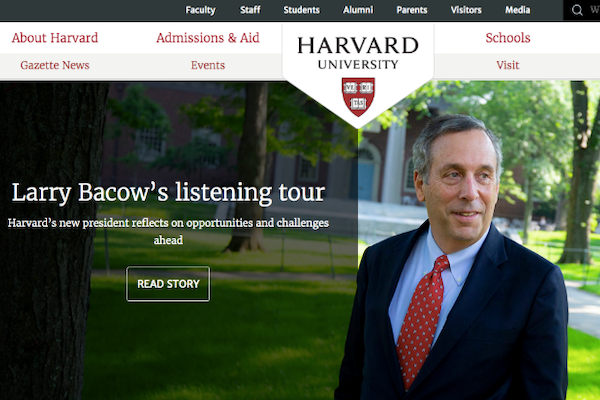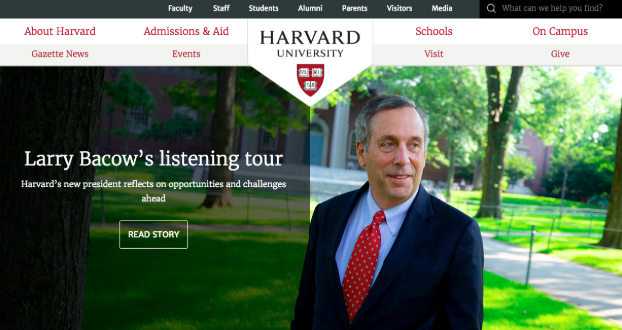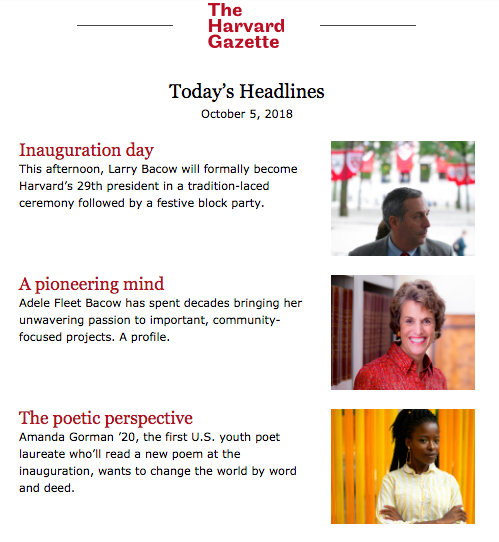Adapting Harvard University’s content for a digital audience, an interview with Mike Petroff

As the oldest American university that’s graduated a ridiculous amount of talent ranging from Thoreau (1837) to Zuckerberg (an honorary doctorate in 2017, 12 years after dropping out), Harvard is one of the most prestigious schools in the world. What does such a storied institution strive to achieve with their content strategy, and how are they making those decisions?
An overarching philosophy, “One Harvard,” guides the university’s content strategy and makes it stand out from the competition, says Mike Petroff, the man who wrangles Harvard’s growing, complex web of information. Ignited in 2013 by then-president Drew Faust, One Harvard centered around the mission of fostering a culture of cooperative innovation, inspired by the notion that the university as a whole is greater than the sum of its thriving parts. And with that, Faust consistently expressed a vision of Harvard as a global institution, graduating students ready to innovate and lead internationally. “The One Harvard campaign was one of the big things that changed the depths of Harvard learning and research,” says Petroff, Harvard’s Director of Content Strategy.

Petroff’s primary objective for content strategy is to amplify Harvard’s mission of excellence in teaching and research, including highlighting this cross-functional, interdepartmental approach to research and innovation: “We’ve learned that audiences are more digital, more mobile, and more global, and that’s where a lot of our work comes into play—how to take Harvard’s mission and research into digital channels.”
Petroff oversees the process of disseminating content on Harvard.edu and its associated sites, The Harvard Gazette news site, as well as Harvard’s social media accounts. His job is to develop innovative and effective ways to bring Harvard University content to the world, acting as a strong partner to the editorial, creative, and media relations teams—all with measurable impact.
“We have tools to measure a broad range of things, including where audiences are coming from,” he says. “It’s a huge task to look broadly at how Harvard is talked about on the Internet and determine the impact that a particular story or message makes on the reader.” And that in a nutshell is what his team is focused on. “There’s so much content about Harvard out there. Sometimes we know that people land on a story and read for 30 seconds, but did it really make an impact? Did it make them more or less informed? That’s the qualitative part that’s hard.”
Here, Petroff talks more about how one of the nation’s top universities thinks about using digital and content to reach the world.

What are some examples of the most effective ways that you’ve brought Harvard content to the world?
One of the projects we’re most excited about is The Harvard Gazette news website redesign, including The Daily Gazette newsletter, which has 150,000 subscribers, and the use of the @harvard social accounts on Twitter, Facebook, and Instagram to amplify the news content. We now understand that within the last five years, Harvard content is not only relevant to interior audiences, but exponentially the audience is growing to include a global audience, including people across the U.S. who tune into Harvard’s research. People around the world want to see what kinds of students are graduating from Harvard and what they’re up to next.
We created a platform to speak to internal and external audiences at the same time. The Harvard Gazette site is a unique site for a university—it’s not just about sharing stories and information with Harvard staff and students, but also about reaching a broader audience by talking about future advances such as climate change. A good portion of the content strategy is editorial strategy—understanding what internal audiences want to know and what the external push-pull is for new audiences.
The Daily Gazette newsletter features a selection of stories they want to highlight; the best engagement is from faculty and staff and also students and alumni. Email is still a very powerful tool, which is surprising despite the younger demographic shift and the fact that Instagram is also becoming a powerful way to reach students on campus. The challenge we’re up against is determining the best ways to share campus news and stories 24 hours a day. We’ve been experimenting a lot with Instagram for taking a daily look at what’s happening at Harvard, and also showing stories that resonate beyond campus, such as important research about opioids. We’ve been asking ourselves, “How do we use our various platforms?”
In general, our internal audiences find our content through our email newsletters, and our external audiences find our content via Google search and social platforms.

Harvard’s audience is broad and diverse. How do you think about Harvard’s “target audience”?
It depends on the campaign or story that we’re publishing. If you have a story directed to graduate students, you don’t need it to go to 200 countries around the world—you just need it to go to the students its applicable to. Let’s say Harvard names a new president, and he started July 1 and has an inauguration in October—we make sure that information is available to everyone. In that case, the story has both a broad and local audience.
When it comes to targeting, we start by asking that question upfront—Who’s the primary audience and the secondary audience? The audience affects what we’re writing and how we’re evaluating and measuring. If the content is not hitting the right audience, it’s not successful.
With The Daily Gazette newsletter, we know the audience, we can understand the type of news a student needs vs. alumni or staff. We’re able to say, “Wow, this story really resonated with this audience but not at all with other audiences.” We can give that info to certain editors about intent and what they can learn for future stories.
How do Harvard content producers and strategists take an entrepreneurial approach?
The interest in and demand for content is growing, but the bandwidth of content producers and strategists at Harvard is not scaling exponentially. The question is, “How do we scale?” Our audience wants to know, in real time, what’s going on at Harvard. On Harvard social channels, we’re creating more relationships with students on campus and aligning with students to help tell stories.
For example, we recently opened the new Smith Campus Center, with a lot of great features for students. We produced the press release and an opening event, and a photo gallery that came from it. We engaged with a student tour guide who led viewers through a live campus tour. We seek out students who are interested in producing this kind of content with us. We’ve worked with students who are photographers and videographers who produced an inside look into student groups.
Students get really excited about sharing their work and information to wider audiences. This kind of collaboration results in really interesting work and creates a strong bond and authentic work to reach a broader audience.
How has readership for Harvard publications and sites evolved?
In some cases, topics we’re covering are becoming more relevant not just because of the Harvard connection but because the topic itself is popular and relevant. For example, the latest information about cancer research is a popular and relevant topic in Google search; people aren’t necessarily seeking out “Harvard cancer research,” but we are able to surface information about our university’s latest cancer research, which is of interest. My team feeds that information back to the editorial team, which they find helpful because they don’t always know what external audiences read and see.
Harvard also has established content partnerships with organizations such as U.S. News & World Report. In these cases, we’re proactively thinking about not just people with a Harvard connection but folks who have connections on topics that Harvard is working on.
How do you empower analytics, and what’s your approach to making analytics friendly for non-analytical people?
We strive to help people understand what metrics mean and why they’re valuable. It’s about more than just metrics; it’s about tying in the connection of metrics of what you want people to do on your website and what you can do to help ensure they come back. The benefits of The Gazette or Harvard.edu site is not about driving ads. It’s about making content relatable and relevant to our audiences. We try to align the metrics relevant to that instead of out-of-the-box metrics that other sites often use.
We connect Harvard’s business goals with the right kind of metrics. We also look at things like Reddit spikes and find the value of that traffic; we’ll ask whether we want to push in that area, or do we want to grow into engaging alumni; questions like these often lead to interesting insights.